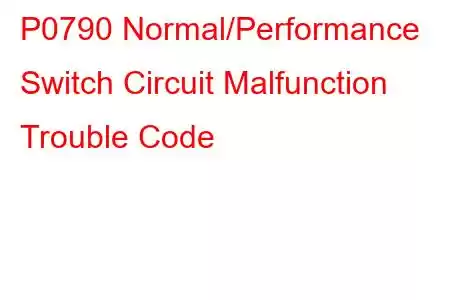P0790 Normal/Performance Switch Circuit Malfunction
OBD-II Trouble Code Technical Description
Normal/Performance Switch Circuit Malfunction
What does that mean?
This is a generic powertrain diagnostic trouble code (DTC) and typically applies to OBD-II vehicles. That may include but is not limited to vehicles from GMC, Chevrolet, Ford, Buick, Dodge, etc. Although generic, the exact repair steps may vary depending on year, make, model and powertrain configuration.
The Transmission Control Module (TCM) monitors all the sensors and switches involved in the operation of the transmission. This day in age, automatic transmissions (a.k.a A/T) have more creature comforts than ever before.
For instance, at times, cruise control is monitored and controlled by the TCM (among possible other modules). For this article, it applies to a normal/performance mode switch, it is enabled by the operator to modify the ratios and shift patterns to accommodate usually higher upshift points and faster downshift points. The operation of this switch is imperative to the functionality of the performance function among other possibly included systems. This will vary significantly between manufacturers so make sure to know WHICH switch applies to your current fault and specific make and model.
The ECM illuminates the MIL (Malfunction Indicator Lamp) with P0790 when it detects a malfunction in the normal/performance switch circuit. The majority of the time, when it comes to this switch, they are located on or near the shift lever. On a stalk-style shifter, it may be a button on the end of the lever. On console-style shifters, it may be on the dash or console. Another factor that varies significantly between vehicles, so refer to your service manual for location.
An example of a stalk-mounted transmission mode switch (normal/performance would be similar):
What is the severity of this DTC?
I would say this is set to low severity. That said, you may want to avoid spirited or hard driving. This may cause you to be putting unneeded stress on the transmission and it's components so be common sensical here.
What are some of the symptoms of the code?
Symptoms of a P0790 trouble code may include:
Mode switch inoperative Erratic and/or abnormal switch operation Inefficient shift pattern Low power Not downshifting when torque is neededWhat are some of the common causes of the code?
Causes for this P0790 code may include:
Defective or damaged switch Corrosion causing high resistance (e.g. connectors, pins, grounds, etc.) Wiring issue (e.g. frayed, open, short to power, short to ground, etc.) Defective shift lever TCM (Transmission Control Module) issue Fuse/box issueWhat are some P0790 troubleshooting steps?
Basic Step #1
Depending on what tools/references you have at your disposal, your start point may be different. That said, if your scanner has any monitoring capabilities (DATA STREAM), you may be able to monitor the values and/or operation of your normal/performance switch. If so, toggle the switch on and off to see if your scanner recognizes your inputs. There may be a lag here so a few seconds delay is always a good idea when monitoring switches.
Not only that, but if you find the mode switch inoperative according to your scanner, you may be able to jump some pins at the mode switch's connector to rule out the circuit. If the circuit is ruled out in this manner, and the switch is still inoperative, I would move on to testing the switch itself. Obviously these are general guidelines but with an moderately able scan tool, troubleshooting CAN be pain-free if you know what you're looking for. Refer to service manual for specs/procedures.
Basic Step #2
Test the switch itself, if possible. Most times, these switches are just to signal to the appropriate module(s) (e.g. TCM, BCM (Body Control Module), ECM, etc.) so it can implement modified shift patterns. That said, the majority of these I've run into are on/off style. This means, that a simple continuity test with an ohm meter can determine the functionality of the sensor. Now, these sensors are sometime incorporated into the shift lever so make sure to research which connectors/pins you need to monitor with your multimeter.
NOTE: As with any transmission fault, always ensure fluid levels and quality are adequate and well maintained.
Read: 42


